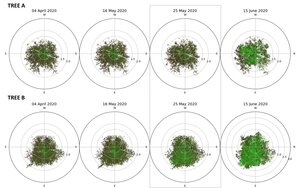~ecology-news-biolog | Bookmarks (419)
-
Galapagos birds exhibit 'road rage' due to noise
A new study has discovered that birds in the Galápagos Islands are changing their behavior due...
-
Scaling agroforestry can support fisheries, local food production and cultural practices
Protecting native forests combined with transitioning fallow and unmanaged agricultural lands to 'Ōiwi (Native Hawaiian) and...
-
Which tree species fix the most carbon?
Forests provide many ecosystem services, including microclimate regulation, biodiversity preservation, air and water purification, and soil...
-
Clarifying a plankton paradox reveals climate risks
The oceans teem with photosynthesizing bacteria, tiny-tailed dinoflagellates gobbling other plankton, algae surrounded by intricate glass...
-
'Musky' marsupial could solve hopping kangaroo mystery
Scientists stalking a small marsupial through a remote Australian rainforest say they may have found a...
-
A mere whiff of penguin poo pushes krill to take frantic evasive action
Imagine looking at the world through the stalked compound eyes of krill in the Southern Ocean....
-
Laser scanning shows trees awaken to spring at their own pace—even within the same species in the same forest
Climatic stress events, such as extreme temperatures and prolonged droughts, are increasingly affecting tree growth and...
-
Thorny skates come in 'snack' and 'party' sizes: After a century of guessing, scientists now know why
When Jeff Kneebone was a college student in 2002, his research involved a marine mystery that...
-
A social immune system: Leafcutter ants recognize and combat pathogens 30 days post-exposure
A study conducted by researchers from São Paulo State University (UNESP), in Brazil, and collaborators shows...
-
Conservation efforts are bringing species back from the brink, even as overall biodiversity falls
A major review of over 67,000 animal species has found that while the natural world continues...
-
Red coral colonies survive a decade after being transplanted in the Medes Islands
The red coral colonies that were transplanted a decade ago on the seabed of the Medes...
-
New 'shy' fungus found in old-growth forest
Although fungi of the genus Piloderma are common, scientists have now discovered five previously unknown species....
-
Discovery of a new species of fossil tree helps paint picture of ancient African forest
Recent research by scientists at the Botanical Research Institute of Texas (BRIT), Texas Tech University, and...
-
First documented sighting of a group of bowhead whales in Canada's Churchill River Estuary
In the summer of 2020, researchers from the University of Manitoba set up a time-lapse camera...
-
Unique dove species is the dodo of the Caribbean and in similar danger of dying out
On first inspection, the Cuban blue-headed quail dove doesn't look like much: drab brown feathers, a...
-
Lost fynbos seeds from underground 'time capsules' in South Africa can grow again, study finds
Underground seed banks in South Africa that date back over 130 years have been found to...
-
How a hummingbird chick acts like a caterpillar to survive
When Jay Falk and Scott Taylor first saw the white-necked Jacobin hummingbird chick in Panama's dense...
-
New method tracks contaminant accumulation in Arctic marine mammals
A new method of tracking the dietary habits and contaminant exposure of animals in Arctic marine...
-
Study finds chain-link fences reduce predator attacks on livestock
A predator's gotta eat, but sometimes what they eat harms people sharing the landscape, and that...
-
How a rapidly growing population of crocs has been impacting Australia's Northern Territories ecosystem
A team of marine biologists, environmental researchers and land management specialists affiliated with several institutions in...
-
Snakes' secret language of ultraviolet color: A hidden world of predator evasion and camouflage
In the study of why and how animals look the way they do, color is king—at...
-
Brown trout can successfully navigate beaver dams, monitoring study shows
A study, led by the University of Southampton (UK), has revealed that brown trout can successfully...
-
Changes in bats' diets can increase spread of viruses and spillover risk
Cornell researcher Raina Plowright and her team observed that when bats in Australia lost access to...
-
World-first analysis of seabirds who've eaten plastic reveals slow, insidious health impacts
We all know microplastics are bad for the environment and our health, but do we really...


















